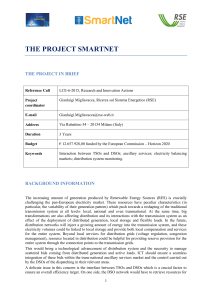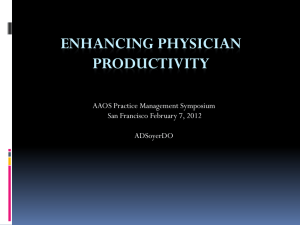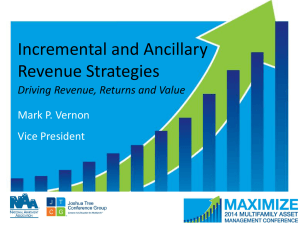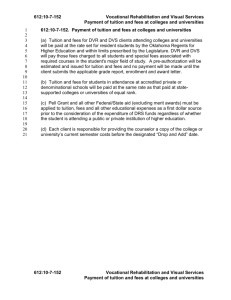File
advertisement
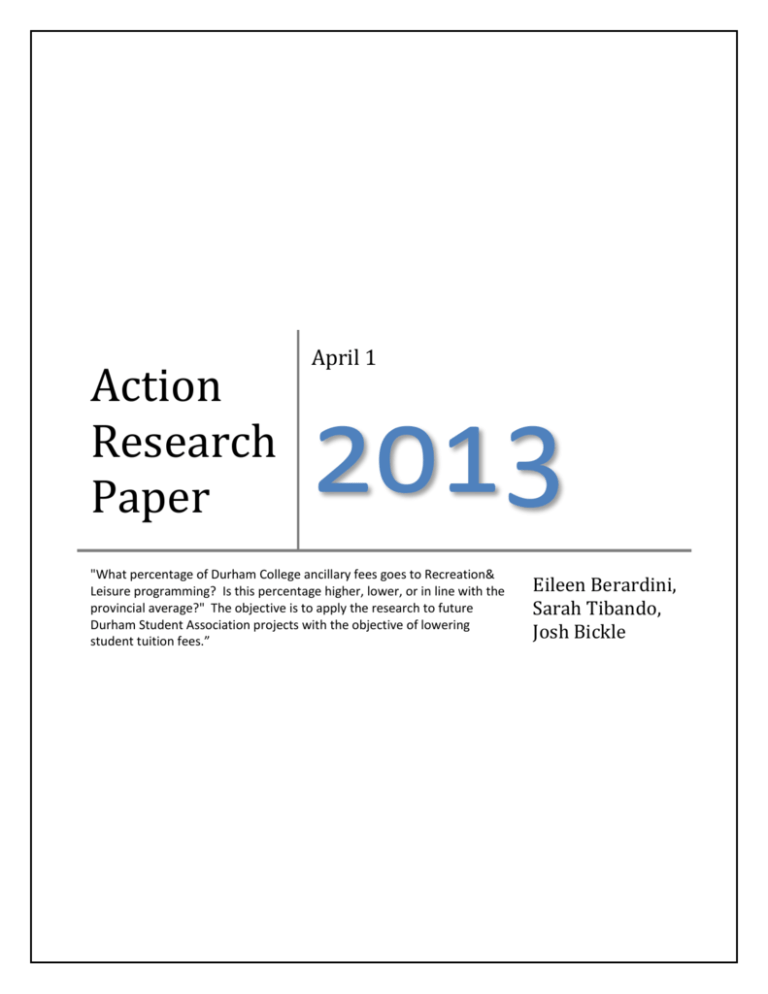
Action Research Paper April 1 2013 "What percentage of Durham College ancillary fees goes to Recreation& Leisure programming? Is this percentage higher, lower, or in line with the provincial average?" The objective is to apply the research to future Durham Student Association projects with the objective of lowering student tuition fees.” Eileen Berardini, Sarah Tibando, Josh Bickle Page 1 of 17 Table of contents INTRODUCTION LITERATURE REVIEW DATA COLLECTION 1. SURVEY Description of Methodology 2. PRIMARY RESEARCH – ANCILLARY FEE PERCENTAGES BREAKDOWN OF ANCILLARY FEES FOR SELECT COLLEGES: CONCENTRATING ON ATHLETICS AND RECREATION Description of Methodology 3. SECONDARY RESEARCH Description of Methodology What are ancillary fees? How are Ancillary fees levied in Ontario? What function do ancillary fees provide? Ministry guidelines concerning ancillary information disbursement Other survey results on ancillary fees Class Action lawsuit on ancillary fees REFLECTION AND ANALYSIS WORKS CITED Page 2 of 17 Introduction Our research is to determine, what percentage of ancillary fees at Durham College go to Recreation and Leisure programming, and whether this percentage is higher, lower, or in line with the Provincial average. Our data collection consists of a survey of how students feel about ancillary fees, primary research on how much students are paying not only at Durham College but across Ontario and what percentage goes towards Recreation and Leisure services, as well as secondary research regarding ancillary fees, what they are, how they are levied and other published survey results on ancillary fees. We plan to apply this research to future Durham Student Association projects, in hopes of lower student tuition fees. Literature review Research Question: "What percentage of Durham College ancillary fees goes to Recreation & Leisure programming? Is this percentage higher, lower, or in line with the provincial average?" The objective is to apply the research to future Durham Student Association projects with the objective of lowering student tuition fees. Methodology: In order to determine the answers to these questions we had to first find out what secondary qualitative and quantitative research had already been done. We also had to identify the quality of sources and how long ago the research had been done. We determined that there were several areas we could explore to find this research: 1. Governmental research from Statistics Canada which would be mostly quantitative Page 3 of 17 2. Student Organizations research which would be both quantitative and qualitative 3. Media reporting which would be primarily qualitative 4. Journals and books containing related research and material Overall, there was very little data specific to our questions concerning ancillary fees going to Recreation & Leisure programming. The secondary research examined ancillary fees in general and further broke down the various components of the fees. No direct research had been found to substantiate our particular research objectives. However, what we were able to find was research that could be used to build our primary research. Government research through Statistics Canada provided general tuition data broken down by province and territory (Statistics Canada) and the Ontario Ministry of Training, Colleges and Universities provided a new ancillary fee policy for which took effect in 2009 (Backgrounder-New Ancillary Fee Policy For Colleges ). A lot of specific ancillary fee research was discovered through student organizations such as The Canadian Federation of Students-Ontario (Our Bright Future), The Ontario Undergraduate Student Alliance (Policy Paper-Ancillary Fees) and the Canadian Student Alliance (2013 Tuition Framework Submission ). Even though this research was undertaken by organizations with a vested interest in lowering tuition fees, the research was conducted through credible academic sources such as McMaster University and the University of Western Ontario. It should be noted that the students’ councils and unions were instrumental in formulated the research. Other data collected for this specific research took the form of media reports. Maclean’s Magazine publishes an annual Guide to Canadian Universities. In the 2011 guide, the magazine included a brief directory of all Ontario Colleges. Although this was the only data collected by the magazine, it aided in our primary research data collection (Maclean's 2013 Edition Guide to Canadian Universities). Other media information dealt directly with qualitative research surveying students’ opinions on ancillary fees. The survey conducted by Metro Newspaper asked students what fees they felt were unfair (Ancillary fees: Have your say). Page 4 of 17 Other media reports dealt with tuition fee hikes and the rising cost of postsecondary education (Give Ontario students a tuition break: Editorial). This research was mostly qualitative and opinion-based citing quantitative secondary data to substantiate opinions. One interesting piece of qualitative research was discovered through news reports and verified by law journals. This had to do with a class-action lawsuit launched by two college students in 2004. The students felt that ancillary fees were a ‘back-door’ way of increasing tuition fees (Coleman and Millar) Our primary quantitative research took two forms: 1. The first was a survey using secondary data collected from existing sources. Since no research had been done to determine the percentage of ancillary fees went to recreation and leisure services. We collected this data by going to individual college websites. We used their public data to compile our own data. 2. The second survey conducted was to gauge student feelings concerning the amount of money they pay into athletic fees and whether they felt the fee was appropriate or too high. The survey was conducted in person and via email through Student Association networks on Durham campus and the College Student Alliance networks on multiple campuses across Ontario. The survey was conducted over a three-week time period from March 4th March 18th. The objective was to find out whether students felt the fees were in line with perceived value of the services that are being rendered through athletic and recreation services on campuses. This is to add additional context to the percentage results that are found from the practical research components of this assignment. Page 5 of 17 Primary Research – Ancillary Fee Percentages College Ancillary Fees College Total Ancillary Fees Recreation Fees Total Recreation Fees % of Recreation Fees Centre Fees Durham $1,387.93 $157.83 $411.24 $569.07 41% Centennial $1,277.12 $150.00 $254.12 $404.12 31.60% Georgian $708.88 $110.97 $110.97 15.60% Niagara $1,024.00 $113.00 $113.00 11% Cambrain $847.00 $182.00 $427.00 48.80% Algonquin $439.02 $200.50 $200.50 45.60% Canadore $988.71 $315.63 $315.63 39.10% Humber $920.34 $146.02 $146.02 15.80% Loyalist 1,014.00 $120.00 $180.00 17.70% Fanshawe $230.19 $38.73 $38.73 16.80% George Brown $578.32 $245.00 $60.00 $75.52 $71.28 $146.80 Average % of Recreation Ancillary Fees 25.30% 28% Description of Methodology In order to find out the amount of ancillary fees paid out by students across Ontario, we had to access multiple different college websites. We chose 11 colleges in total and these colleges were chosen at random. We added up to total cost of ancillary fees for each college and then determined the amount paid into Recreation and Leisure programming. We then took the percentages for each college to get an overall average percentage of ancillary fees geared towards Recreation and Leisure. Page 6 of 17 Student Survey Proper Too High Too Low No Yes Over a three week period students were surveyed from across several college campuses across Ontario including Durham College, St. Clair College (Chattam), Fanshawe College, and Centennial College. The survey results were reduced to 3,000 with five questions and are displayed in the graph above. Q1: Are you aware that in your ancillary fees that you pay various different athletic and recreation fees? A1: 78.2% responded yes: 21.8% responded no Q2: If you answered yes to question 1, do you know how much you pay? A2: 13.3% responded yes: 86.7% responded no Q3: Do you use recreation or athletic resources on campus? A3: 33.7% responded yes: 66.3% responded no Q4: If you were told the average that every student pays into athletics and recreations was $150, would that be too high, too low, or about right? A4: 90.7% responded too high: 1.2% responded too low: 8.1% responded proper Page 7 of 17 Q5: Do you feel you pay too much into athletic and recreation services? A5: 81.6% responded yes: 18.4% responded no SECONDARY RESEARCH Description of Methodology In order to gather already existing data concerning ancillary fees we first had to go back to the beginning and explore exactly what ancillary fees are, how they are levied in Ontario and why, if any other research has been done concerning these fees and if there have been any previous discussions surrounding their use, students’ concerns with them and changes to guidelines. To conduct this research we researched information distributed by various student groups, such as the College Student Alliance, the Canadian Federation of Students (Ontario), numerous individual college websites and the Ministry of Training, Colleges and Universities. We also investigated newspaper articles and law journals to seek out information concerning class action lawsuits launched by students with respect to the misuse of ancillary fees and the outcome of these suits. What are ancillary fees? Mandatory ancillary fees are defined as those fees that support services and activities and not included in tuition fees or capital grants or supported by the General Purpose Operating Grant. Every year, mandatory ancillary fees have increased overall at nearly every college (2013 Tuition Framework Submission ). How are ancillary fees levied in Ontario? According to the Ministry of Training, Colleges and Universities’ website, the current student fee policy came into effect in the 2009-10 academic year. The website says: Page 8 of 17 ‘The policy governing ancillary fees were reviewed in 2006 and an updated policy clarifying what fees can and cannot be charged by colleges and student associations was decided upon. Under the new policy, ancillary fees may be charged only for services and items not covered by tuition fees or government funding. Extended health insurance plans, overnight class trips and enhanced information technology services are examples of items for which colleges may choose to charge ancillary fees. Extracurricular athletics, student centres and student clubs are examples of items for which student associations may choose to charge ancillary fees’ (Backgrounder-New Ancillary Fee Policy For Colleges ). What function do ancillary fees provide? ‘Compulsory ancillary fees are non-tuition related fees that are not intended to pay for items that support the general operation of program delivery at colleges and universities. They are collected to pay for items that are intended to enhance student life and don’t apply directly to the academic mission of the institution. Post-secondary institutions must adhere to guidelines around compulsory ancillary fees that are outlined in the Minister’s Binding Policy on Tuition and Ancillary Fees (colleges) and Operating Funds Distribution Manual (universities). According to research from the Ontario Federation of Student, ‘in addition to paying the highest tuition fees, students in Ontario pay the highest ancillary fees in the country. College and university students in the province pay ancillary fees ranging between $441 and $2,680 per year’ (CHANGING PRIORITIES: MOVING TOWARDS AFFORDABLE POST-SECONDARY EDUCATION 20). Page 9 of 17 Ministry guidelines concerning ancillary information disbursement According to student organizations who have been researching the increase in ancillary fees over the years, they say that information is very difficult to obtain from the government. The government does not share this information readily. Perhaps student groups who require this information may have to see legal avenues such as the Access of Information Act to request documentation release. The Minister’s Binding Policy Directive on Tuition and Ancillary Fees and the Tuition and Ancillary Fees Reporting Operating Procedure poses transparency problems because current MTCU guidelines are not easily accessible to student associations when they implement new fees or review existing fees. The documents governing mandatory ancillary fees are not publicly available but accessible only on a password-protected website to which neither student governments nor the public have access. (2013 Tuition Framework Submission 11) Current tuition fees in Ontario are funded through a number of sources: Government grants (49.8%) Regulated tuition (15%) Student and ancillary revenue (12.4%) Other revenue (10.5%) Unfunded and international tuition (7.2%) Additional cost-recovery tuition (4%) Apprenticeship classroom fees and other tuition (1.1%) Total revenue of $3.4 billion is generated, of which regulated tuition contributes roughly $510 million (2013 Tuition Framework Submission 3). Page 10 of 17 The Canadian Federation of Students says that ancillary fees have been increasing in the last 10 years, and some of these items fall outside the scope of what ancillary fees were designed for. Other survey results on ancillary fees A survey was taken in the February 3rd, 2013 edition of Metro News titled: Ancillary fees: Have your say. It took a poll of readers on a survey question and itemized some interesting things that were charged as ancillary fees. Page 11 of 17 (Our Bright Future) Page 12 of 17 (CHANGING PRIORITIES: MOVING TOWARDS AFFORDABLE POST-SECONDARY EDUCATION) Page 13 of 17 Class Action lawsuit on ancillary fees ‘In 2007, two college students launched a class action lawsuit against Ontario’s 24 public colleges to bring attention to the wide-spread collection of prohibited ancillary fees. In response, the government changed ancillary fee regulations to allow for the collection of previously prohibited fees in the college sector (Our Bright Future 17) . ‘Amanda Hassum and Dan Roffery, two students at Conestoga College and George Brown College sued Ontario colleges for $200 million, saying ancillary fees they paid were illegal. The students felt that ancillary fees were a ‘back-door’ way of increasing tuition fees.They were seeking damages for all students who had paid the fees since 2004. In Ontario, it is illegal for post-secondary institutions to enforce compulsory tuition-related ancillary fees. Compulsory non-tuition fees can only be charged if approved by a student referendum. The two students argued that the government knew that the fees were being collected illegally and did nothing to stop the colleges. (Coleman and Millar) The Colleges of Universities disputed the students’ arguments saying that there were regulations in place and that: “Universities can’t just jack up (fees) for the sake of bringing more revenue in,” said Bonnie Patterson, president of the Council of Ontario Universities. “If they go up, they are reflective of the costs of whatever service is being provided” (Student Fees: Making a profit or cost recovery?). The result was that the students lost the case, but the Ministry still went ahead and changed the guidelines to make the colleges more accountable. Page 14 of 17 REFLECTION AND ANALYSIS Overall answering the posed research question became very easy. The percentage of ancillary fees is 41% and based off the sample size of the 11 colleges surveyed the average is 28%. From that initial data it is quite obvious that Durham College students pay well above the provincial average, by 13%. However it is also fair to assess that the research analysis does not take into consideration the facilities and programing being offered by each institution to determine the value. The strong piece of research to support our claim is the opinions of the students themselves, it was very clear that students feel that they pay far too much into recreation, leisure, and athletics on their campuses. It is even further arguable that most students don’t even have a full understanding of what they pay in general and that these type of facilities are highly underutilized compared to the amount of students paying into them. Another question that has risen from the research is if these fees are even being levied and increased following proper fee protocol as institutions are always seeking ways to generate new revenue streams. The purpose of collecting this data is finding a way to progress in the reduction of student fees. The trend of increasing fees is one that is worrisome at best more so when coupled with the low per-student funding in comparison to other provinces across Ontario. Moving forward the best bet is to continue to expand on the data produced in this document. We could do this by expanding to include all post-secondary institutions in Ontario and getting a cost break down of all fees in comparison to recreation use. Further data should also be collected to see the types of facilities and programing being offered at all the PSE institutions to gather a wider variety of empirical data in which to draw from when creating a case. In the short term the data that has been collected can be moved forward to the local Student Association as hard evidence that fees are rising at a vast rate and over the current provincial average. This will give them the ability to begin the creation of a strategy to lower fees starting at a local level. It will also begin to raise questions to many of the larger issues and questions that have come from Page 15 of 17 the paper. Recreation and athletic fees are not the only fees involved, other ancillary fees as well as tuition fees are on the rise. A second paper should be research and authored around the process that is used to levy fees in all cases and ensure that they are in line with provincial procedure and protocol. Much of this will involve cooperation with the provincial government’s MTCU department as well as local institutions. This paper should focus on solutions to lowering these fees if it is found that they are ballooning too high or are completely out of control. For the immediate future a local analysis should now be done of Durham College’s recreation and athletic centres and their utilization, budget, and yearly costs to operate. The data, supports a strong conclusion that our current recreation and athletic fees are too high and that we need to take a more detailed look to ensure that the fees we are paying are being utilized on campus. It would be fair to say that an analysis to see what percentage of students utilize that facilities and services that are offered to determine if it is a majority or not would be in order. Many questions have been raised from the answers that have been provided and it would see this is just the preliminary research to start the way. More data needs to be collected and more questions need to have answers in order to provide a possible solution to the rising tuition fees and start the path in earnest. Page 16 of 17 Works Cited "2013 Tuition Framework Submission ." December 2012. College Student Alliance. http://www.collegestudentalliance.ca/wp-content/uploads/2012/12/Tuition-Submission-Dec2012-FINAL-PDF.pdf. 20 February 2013. Algonguin College-basic tuition. 2013. http://www3.algonquincollege.com/ro/pay/tuition-andexpenses/20122013-2/basic-tuition/. 7 March 2013. "Ancillary fees: Have your say." 6 February 2013. Metro News. http://metronews.ca/features/dollarsfor-diplomas/537423/ancillary-fees-have-your-say/. 10 March 2013. "Backgrounder-New Ancillary Fee Policy For Colleges ." 26 September 2008. Ministry of Training, Colleges and Universities. http://www.tcu.gov.on.ca/eng/document/nr/08.09/bg0926.html. 7 March 2013. Cambrian College - Tuition fees. 2013. http://www.cambriancollege.ca/Departments/OfficeofTheRegistrar/Pages/TuitionandFees.aspx. 2013. Canadore College - Admissions Fees. 2013. http://www.canadorec.on.ca/admissions/fees. 7 March 2013. Centennial College-Incidental Fees. 2013. http://www.centennialcollege.ca/incidentalcert. 7 March 2013. "CHANGING PRIORITIES: MOVING TOWARDS AFFORDABLE POST-SECONDARY EDUCATION." February 2013. Canadian Federation of Students-Ontario. http://cfsontario.ca/downloads/CFSChangingPriorities-En.pdf. 7 March 2013. Coleman, Joey and Erin Millar. "Class action suit accuses Ontario colleges of violating provincial ancillary fee law." MacLeans Magazine 5 June 2007. http://oncampus.macleans.ca/education/2007/06/05/students-launch-lawsuit-against-ontariocolleges/. Durham College-Other Fees To Consider. 2013. http://www.durhamcollege.ca/financial-info/tuition-andfees/other-fees-to-consider. 7 March 2013. Fanshaw College - Ancillary Fees. 2013. http://www.fsu.ca/ancillary_fees.php. 7 March 2013. George Brown-How Much Will College Cost? 2013. http://www.georgebrown.ca/how_much_will_college_cost.aspx. 7 March 2013. Georgian admission fees. 2013. http://www.georgianc.on.ca/admissions/apply/standard-fees. 9 March 2013. "Give Ontario students a tuition break: Editorial." The Toronto Star. Toronto: Torstar, 5 March 2013. http://www.thestar.com/opinion/editorials/2013/03/05/give_ontario_students_a_tuition_brea k_editorial.html. Page 17 of 17 Humber College Fees. 2013. http://www.humber.ca/fees. 7 March 2013. Loyalist College-Costs. 2013. http://www.loyalistcollege.com/student-services/financial-options/collegecosts. 7 March 2013. Maclean's 2013 Edition Guide to Canadian Universities. 1 November 2012. http://oncampus.macleans.ca/education/. 03 03 2013. Niagara College-Fee and Payment Information. 2012. http://www.niagaracollege.ca/content/FeesandPaymentInformation/TuitionandAncillaryFees.as px. 7 March 2013. "Our Bright Future." November 2009. Canadian Federation of Students-Ontario . http://cfsontario.ca/downloads/CFS-PSE%20Secretariat-Tuition%20Fees.pdf. 20 February 2013. Policy Paper-Ancillary Fees. March 2011. http://www.ousa.ca/dev/wpcontent/uploads/2011/03/Ancillary-Fees.pdf. 03 03 2013. Seneca College Fees. 2013. http://www.senecac.on.ca/fulltime/stuserv/fees_info.html. 7 March 2013. Statistics Canada. 16 06 2009. http://www.statcan.gc.ca/tables-tableaux/sum-som/l01/cst01/educ47aeng.htm. 03 03 2013. "Student Fees: Making a profit or cost recovery?" Metro News. Toronto, 6 February 2013. http://metronews.ca/features/dollars-for-diplomas/537674/537674/.
